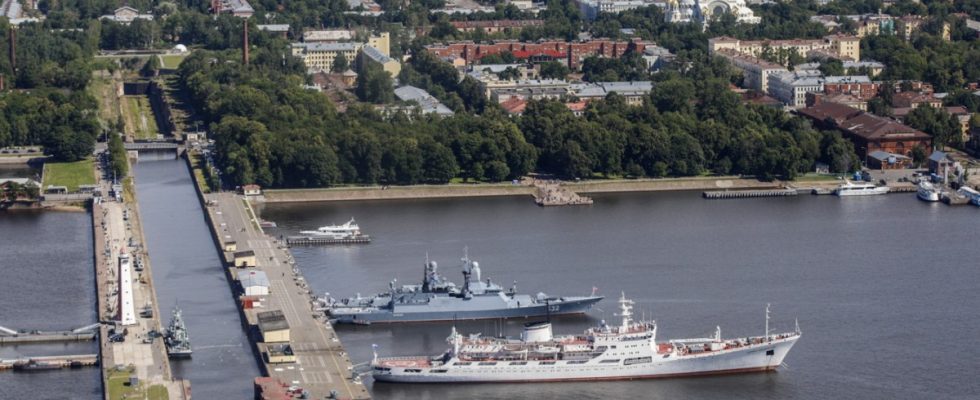The sea is difficult to monitor. There are 9,000 kilometers of pipes, lines and cables on the seabed off the Norwegian coast alone. When the two Nord Stream pipelines in the Baltic Sea were damaged by explosions on September 26 last year, the defense ministers and naval chiefs of Finland, Denmark, Sweden and Norway set up crisis teams on the same day. Since then, they have been helping each other with the coordinated surveillance of their sea areas in the Baltic Sea, North Sea and Atlantic, and with a joint presence in their waters.
Journalists from the four Nordic countries apparently had a very similar idea: last spring, the public broadcasters Danmarks Radio (DR), Sveriges Television (SVT), Norsk rikskringkasting (NRK) and Yle from Finland formed a joint investigative team that has since activities of the Russian Navy in the Baltic Sea and North Sea and went public with his research on Wednesday. As a result, Russian civilian ships have been specifically mapping wind farms, gas pipelines, and power and network cables for years. Yesterday, Wednesday, the four broadcasters switched the first episode of their three-part documentary “The Shadow War” (The Shadow War) free.
Fishing trawlers may be upgraded militarily
Among other things, the journalists researched the so-called AIS positions of several hundred civilian Russian ships from 2013 onwards and combined them into movement maps. AIS, the Automatic Identification System, is used to locate all ships at sea. The ships are actually obliged to leave their respective AIS transponders switched on permanently. The journalists were able to see intercepted Russian radio messages that indicate that so-called ghost ships are regularly navigating the Nordic waters, i.e. ships that switch off their AIS transponders.
Thanks to a bilateral agreement, Norwegian and Russian trawlers were allowed to fish in the waters of the other country and also land their catch in the ports there until the outbreak of the Ukraine war. However, last summer Russia changed its naval doctrine, which sets out the country’s naval defense strategy. Since then, theoretically every civil research ship, every freighter and every fish trawler can be upgraded to military standards.
Russian ships are now only allowed to land their catch in three ports. The documentary tells of two fishing boats that anchored in one of these three ports in Kirkenes, northern Norway, in November last year. During the routine check, the Norwegian Coastal Police found that the boats had extremely powerful radios in locked rooms that were not connected to the rest of the electronics on board.
A research ship sails for weeks with the transponder switched off
In November 2021, four and a half kilometers of cable and massive anchorages were torn from the seabed off the northern Norwegian Vesterålen Islands and towed several nautical miles. The Norwegian Institute of Marine Research has laid a 60-kilometer network in the area, which is used, among other things, to be able to track Russian submarine movements off the Norwegian coast more closely. The missing cables weighed a total of nine and a half tons. In January 2022, a cable leading from Svalbard to mainland Norway was severed. The AIS data clearly shows that Russian ships were on site when the cables were damaged: before the Spitsbergen cable was cut, a trawler sailed up and down the affected area 130 times. The only reasonable explanation for the strange movement patterns of other ships off the Norwegian coast is that fine-meshed bottom reliefs were created here with sonar.
But the reporters also tracked down strange ships in Swedish and Danish waters. The Russian Admiral Vladimirsky, which is officially used for research expeditions, sailed through the Baltic and North Seas for weeks in 2022 with the AIS transponder switched off. Danish intelligence officials say in the documentary the ship mapped wind farms, gas pipelines, power lines and internet cables at sea. In November, the ship passed through at least two naval exercise areas of the Swedish Armed Forces. As the TV crew approached the ship, several masked men in bulletproof vests came on deck, one carrying an automatic weapon. Later she drove Vladimirsky seven wind farms off the British and Dutch coasts.
The investigative team concludes that at least 50 Russian ships have been conducting systematic espionage for the past decade.
After the Nord Stream explosion, an analyst at the Naval Academy in Oslo called Russian fishing boat traffic along the Norwegian coast “the Achilles’ heel of our security”. After viewing this documentary, one understands very well what she meant by that.

